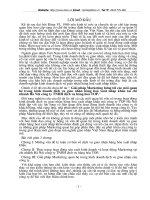Rethinking Marketing
Bạn đang xem bản rút gọn của tài liệu. Xem và tải ngay bản đầy đủ của tài liệu tại đây (3.61 MB, 35 trang )
以客之拚行
銷
老師教授:陳怡穆
學生:阮文沙
摘要 SUMMARY
• 簡述 - Idea in Brief
• 培養顧客 - Cultivating Customers
• 行銷再造 - Reinventing Marketing
• Customer-facing functions
• Market Analysis
• Customer Profile
• A New Focus on Customer Metrics
簡述
IDEA IN BRIEF
文章的主要 內容是
The main of article is that
Companies have powerful technologies for understanding and
interacting with customers, yet most still depend on mass media
marketing to drive impersonal transactions.
companies must shift
their focus from
driving transactions to
maximizing customer
lifetime value
making products and
brands subservient to
long-term customer
relationships
changing strategy and
structure across the
organization—and
reinventing the marketing
department altogether
培養顧客
CULTIVATING CUSTOMERS
The key distinction
between a traditional
and a customercultivating company is
that one is organized to
push products and
brands whereas the
other is designed to
serve customers and
customer segments.
「 產品經理人」導向 產品經理人」導向
PRODUCT-MANAGER DRIVEN
許多公司仍依賴產品經理人,運用單向的大眾行銷
,向大量的顧客推友產品。
Many companies still depend on product
managers and one-way mass marketing to
push a product to many customers.
「 產品經理人」導向顧客經理人」導向
CUSTOMER-MANAGER DRIVEN
What’s needed is customer managers who engage
individual customers or narrow segments in two-way
communications, building long-term relationships by
promoting whichever of the company’s products the
customer would value most at any given time.
B2B
例如
EXAMPLE
B2C
B2B 公司
B2B COMPANIES
Use key account managers and global account directors to
focus on meeting customers’ evolving needs, rather than
selling specific products
Instead of focusing on
short-term product sales,
IBM measures the
practice’s performance
according to long-term
customer metrics.
B2C 公司
B2C COMPANIES
some B2C companies are making notable progress. Increasingly,
they view their customer relationships as evolving over time, and
they may hand off customers to different parts of the organization
selling different brands as their needs change.
American Express actively
monitors customers’ behavior
and responds to changes by
offering different products. The
firm uses consumer data
analysis and algorithms to
determine customers’ “next best
product” according to their
changing profiles and to manage
risk across cardholders
the company might use demographic
data, customer purchase patterns, and
credit information to observe that a
cardholder has moved into a new home
AmEx capitalizes on that life event by offering special Membership Rewards on
purchases from merchants in its network in the home-furnishings retail category.
REINVENTING
MARKETING
The traditional marketing department must be reconfigured as a customer
department that puts building customer relationships ahead of pushing specific
products.
The first order of business is to replace the traditional CMO with a new type of
leader—a chief customer officer.
CHIEF
CUSTOMER
OFFICERS
(CCO)
A successful CCO promotes a
customer-centric culture and
removes obstacles to the flow
of customer information
throughout the organization.
This includes getting leaders
to regularly engage with
customers.
the CCO is accountable for
increasing the profitability
of the firm’s customers
as measured by metrics such
as customer lifetime value
(CLV) and customer equity as
well as by intermediate
indicators, such as word of
mouth (or mouse).
CUSTOMER
MANAGERS.
In the new customer department, customer and segment managers identify customers’
product needs. Brand managers, under the customer managers’ direction, then supply the
products that fulfill those needs.
This structure is common in the B2B world. In its B2B activities, Procter & Gamble, for
instance, has key account managers for major retailers like WalMart. They are less interested
in selling
In a customer cultivating company, a consumer-goods segment manager might offer
customers incentives to switch from less-profitable Brand A to more profitable Brand B.
This wouldn’t happen in the conventional system, where brand and product managers
call the shots.
Brand A’s manager isn’t going to encourage customers to defect—even if that would
benefit the company—because he’s rewarded for brand performance, not for improving
CLV or some other long-term customer metric. This is no small change: It means that
product managers must stop focusing on maximizing their products’ or brands’ profits
and become responsible for helping customer and segment managers maximize theirs.
WHAT
MAKES A
CUSTOMER
MANAGER?




